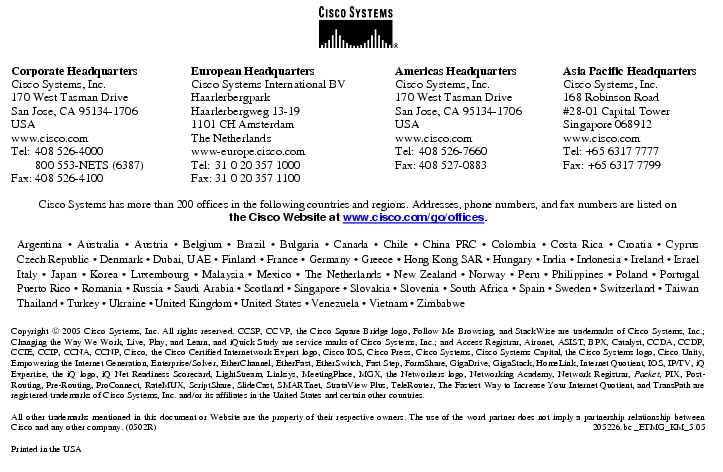Q&A
Q. What is the Cisco WebVPN Services Module?
A. The WebVPN Services Module incorporates remote-access Secure Sockets Layer (SSL) VPN supports into a Cisco Catalyst 6500 and 7600 Series.
Q. Is the Cisco WebVPN Services Module the same as the SSL Services Module?
A. No. These are two different modules.
Q. Can I upgrade my SSL Services Module to a WebVPN Services Module?
A. No. You cannot load SSL VPN images on the SSL Services Module, or load SSL images on the SSL VPN Services Module.
Q. What are the part numbers for the Cisco WebVPN Services Module?
A. The hardware part number for the Cisco SSL VPN Services Module is WS-SVC-WEBVPN-1-K9.
Q. What supervisor engines are compatible with the Cisco WebVPN Services Module?
A. The Cisco WebVPN Services Module supports a Supervisor Engine 2/MSFC2 or a Supervisor Engine 720 (with a PFC3A, PFC3B, or PFC3b-XL). The Supervisor Engine 1A is not supported.
Q. Does the Cisco WebVPN Services Module work in Cisco 7600 Series chassis?
A. Yes.
Q. Does the Cisco WebVPN Services Module run Cisco IOS Software?
A. WebVPN Services Module runs an image that is based on IOS.
Q. Does the Cisco WebVPN Services Module support IPSec VPN?
A. No. The Cisco WebVPN Services Module does not support IPSec, but it can be combined with the IPSec Services Module in the Cisco Catalyst 6500 Series chassis to offer both IPSec and SSL VPN services from the same chassis, if needed.
Q. Does the Cisco WebVPN Services Module run the same software as Cisco VPN 3000 Series concentrators?
A. The Cisco WebVPN Services Module runs an image that is based on Cisco VPN 3000 Series concentrators feature set but it is a different image.
Q. Can I put the Firewall Services Module, VPN Services Module, and WebVPN Services Module together in the chassis?
A. Yes.
Q. Does the Cisco WebVPN Services Module have any external interfaces?
A. The Cisco WebVPN Services Module does not have any external ports. It is based on traffic configured on VLANs to the module.
Q. How many VLANs can I configure to the Cisco WebVPN Services Module?
A. There is no limit, as long as traffic does not exceed the aggregate traffic limit of the Cisco WebVPN Services Module.
Q. How many Cisco WebVPN services modules can I put on one chassis?
A. Up to four Cisco WebVPN services modules are supported per chassis.
Q. Does the Cisco WebVPN Services Module support failover?
A. Yes. Failover is supported using Cisco IOS Software server load balancing (SLB) or the Content Switching Module (CSM).
Q. When I use the Cisco WebVPN Services Module in full tunnel mode, does it download a client dynamically? If so, how long does it take?
A. Yes. In full tunnel mode, a client is automatically downloaded. The client is small and should take less than one minute to download.
Q. How many virtual contexts does the Cisco WebVPN Services Module support?
A. The Cisco WebVPN Services Module supports up to 128 contexts.
Q. Is there a service maintenance cost?
A. Yes. Service maintenance costs for the Cisco WebVPN Services Module are comparable to Cisco's other services modules for Catalyst 6500 and 7600.
Q. Does the Cisco WebVPN Services Module work in any Cisco Catalyst 6500 or 7600 Series chassis?
A. Yes. The Cisco WebVPN Services Module is fabric-enabled and should work in any Cisco Catalyst 6500 or 7600 Series chassis form factor.
Q. How much flash and DRAM memory is available on board? Can the DRAM be upgraded?
A. The Cisco WebVPN Services Module comes with 128 MB of flash memory and 1 GB of DRAM. The DRAM is not upgradeable.
Q. How is redundancy supported?
A. Stateless failover is supported both within the chassis and across chassis.
Q. Is the Cisco WebVPN Services Module supported in both native Cisco IOS Software and hybrid systems?
A. Yes.
Q. Does the Cisco WebVPN Services Module support split tunneling?
A. Yes.
Q. How is geographic diversity supported with a Cisco WebVPN Services Module for a high-availability data center?
A. Global server load balancing is offered by the Global Site Selector (GSS). It can support high availability of Cisco WebVPN services modules that are deployed in separate geographic areas.
Q. Do you need to build a Web portal to use the Cisco WebVPN Services Module?
A. No additional portal is needed. The Cisco WebVPN Services Module uses the same interface and management method as IPSec and Cisco VPN 3000 Series concentrators to configure SSL VPN.
Q. Do companies require both SSL VPN and IPSec? Will most companies need to deploy both at some point?
A. Many customers have expressed interest in simultaneously supporting SSL VPN and IPSec connectivity. With its integrated service modules, Cisco enables you to support all of your remote-access needs on a single Cisco Catalyst switch.
Q. What modes does the Cisco WebVPN Services Module support?
A. The Cisco WebVPN Services Module supports three modes:
– Clientless SSL sessions,
– Thin client, also known as port forwarding
– Full SSL tunneling
